Analyzing Reflective Learning, Feedback, and Future Assessments
VerifiedAdded on 2023/06/10
|8
|2217
|248
Essay
AI Summary
This essay provides an overview of reflective learning, emphasizing its importance in enhancing students' learning experiences. It discusses approaches to feedback, including feedforward, using the Gibbs learning cycle as a framework. The essay examines the nature of feedback and feedforward, highlighting their roles in shaping future formative and summative assessments. It covers the significance of reflective learning in developing critical thinking skills and promoting self-awareness among learners. The discussion includes formative and summative assessment methods, explaining how they contribute to the learning process and offering insights into improving individual performance. The document is available on Desklib, a platform offering a variety of study resources for students.
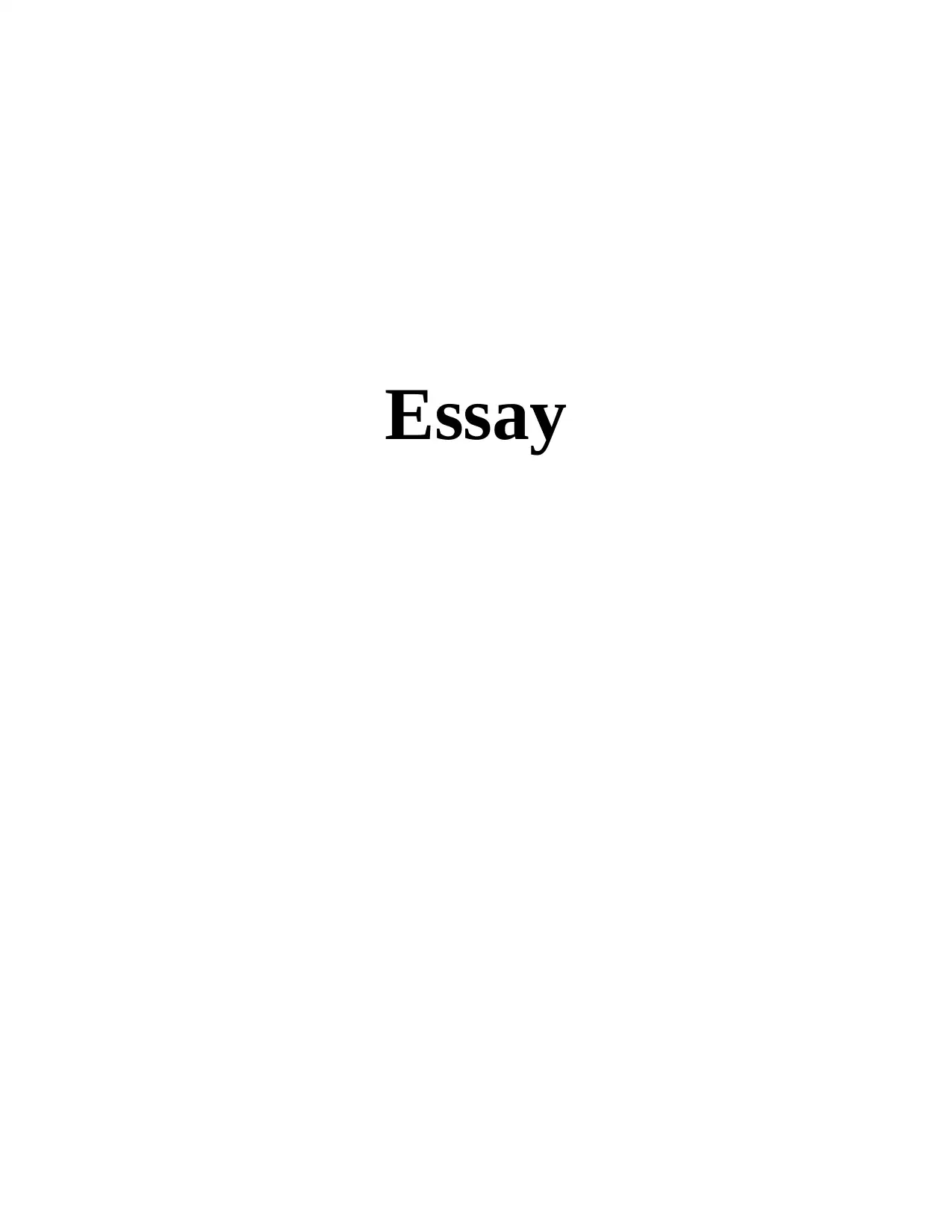
Essay
Paraphrase This Document
Need a fresh take? Get an instant paraphrase of this document with our AI Paraphraser
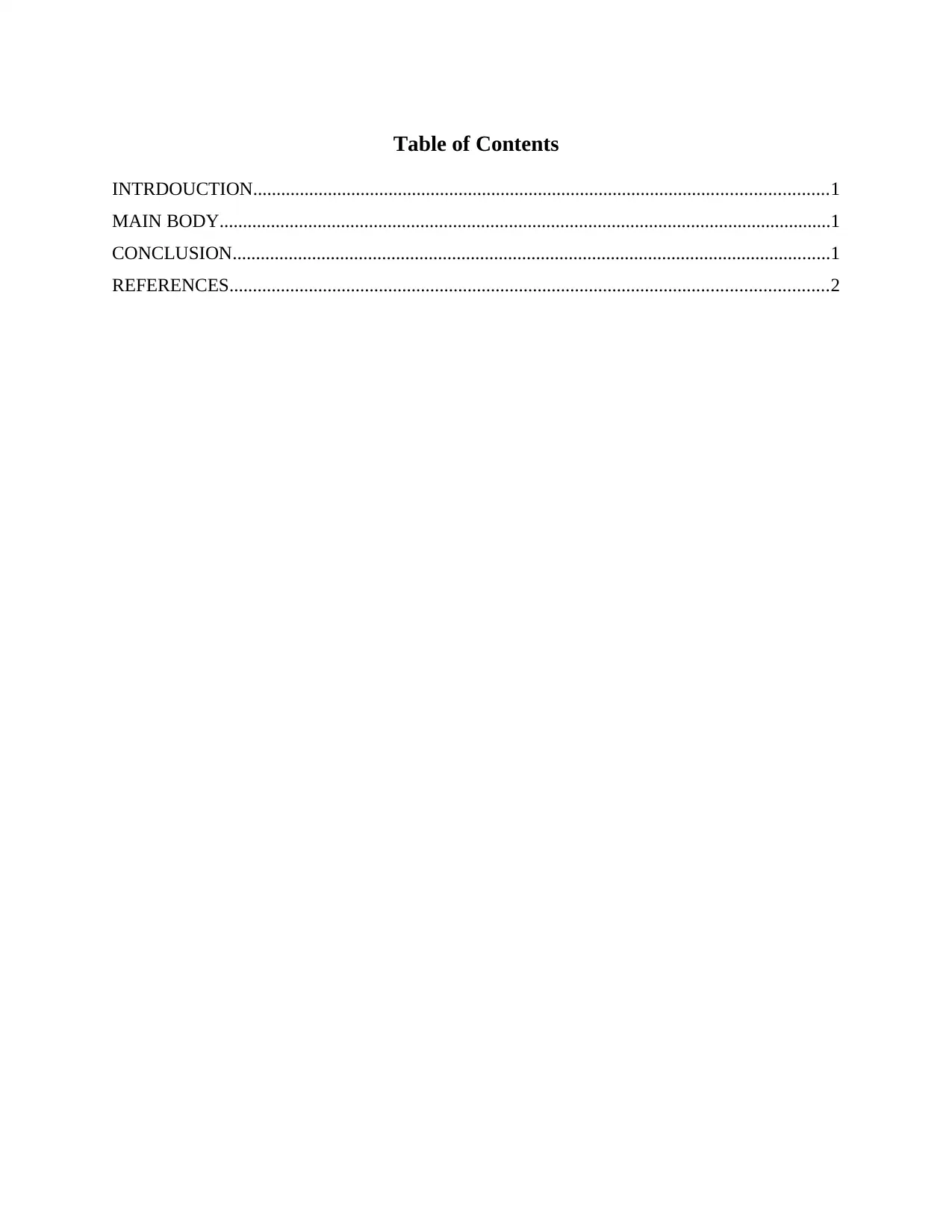
Table of Contents
INTRDOUCTION...........................................................................................................................1
MAIN BODY...................................................................................................................................1
CONCLUSION................................................................................................................................1
REFERENCES................................................................................................................................2
INTRDOUCTION...........................................................................................................................1
MAIN BODY...................................................................................................................................1
CONCLUSION................................................................................................................................1
REFERENCES................................................................................................................................2
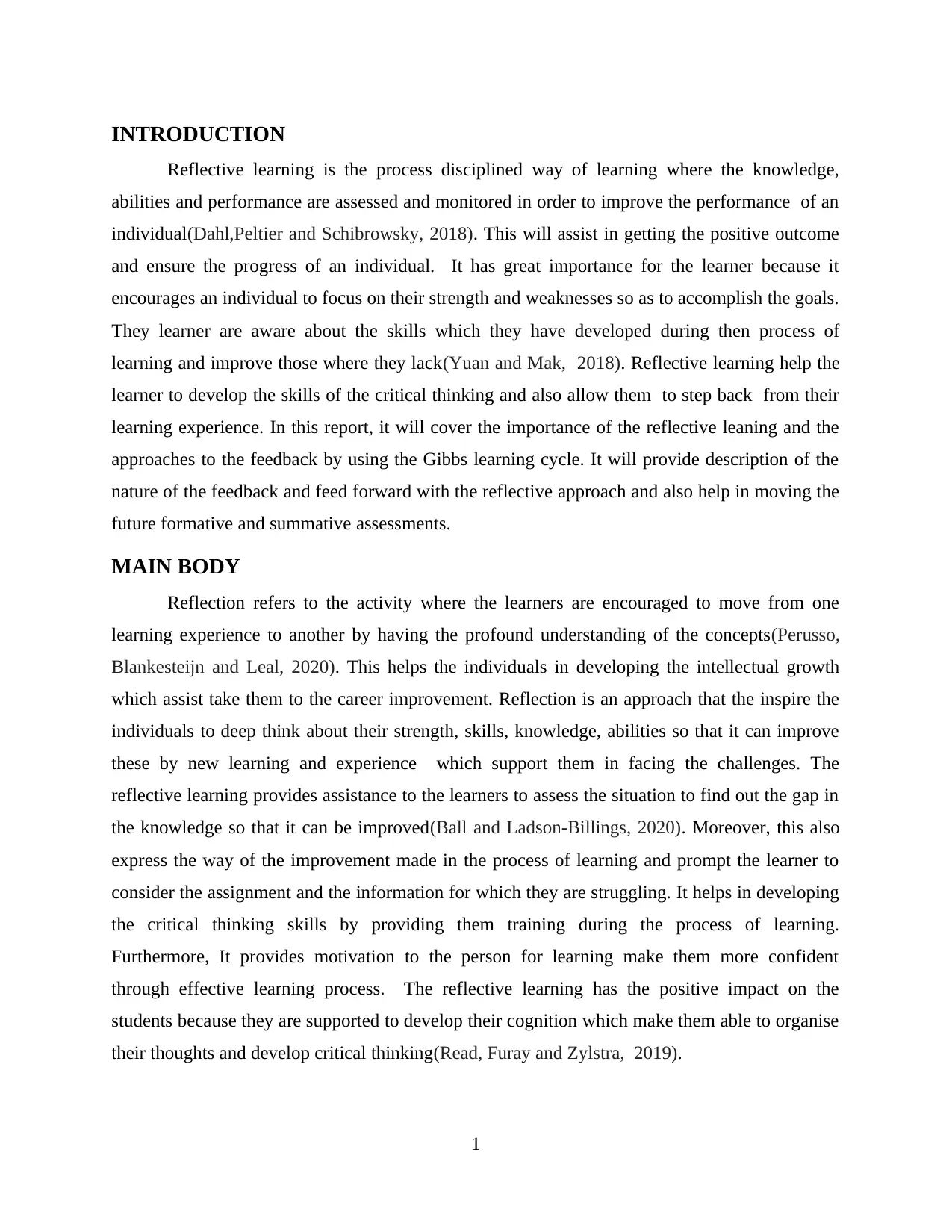
INTRODUCTION
Reflective learning is the process disciplined way of learning where the knowledge,
abilities and performance are assessed and monitored in order to improve the performance of an
individual(Dahl,Peltier and Schibrowsky, 2018). This will assist in getting the positive outcome
and ensure the progress of an individual. It has great importance for the learner because it
encourages an individual to focus on their strength and weaknesses so as to accomplish the goals.
They learner are aware about the skills which they have developed during then process of
learning and improve those where they lack(Yuan and Mak, 2018). Reflective learning help the
learner to develop the skills of the critical thinking and also allow them to step back from their
learning experience. In this report, it will cover the importance of the reflective leaning and the
approaches to the feedback by using the Gibbs learning cycle. It will provide description of the
nature of the feedback and feed forward with the reflective approach and also help in moving the
future formative and summative assessments.
MAIN BODY
Reflection refers to the activity where the learners are encouraged to move from one
learning experience to another by having the profound understanding of the concepts(Perusso,
Blankesteijn and Leal, 2020). This helps the individuals in developing the intellectual growth
which assist take them to the career improvement. Reflection is an approach that the inspire the
individuals to deep think about their strength, skills, knowledge, abilities so that it can improve
these by new learning and experience which support them in facing the challenges. The
reflective learning provides assistance to the learners to assess the situation to find out the gap in
the knowledge so that it can be improved(Ball and Ladson-Billings, 2020). Moreover, this also
express the way of the improvement made in the process of learning and prompt the learner to
consider the assignment and the information for which they are struggling. It helps in developing
the critical thinking skills by providing them training during the process of learning.
Furthermore, It provides motivation to the person for learning make them more confident
through effective learning process. The reflective learning has the positive impact on the
students because they are supported to develop their cognition which make them able to organise
their thoughts and develop critical thinking(Read, Furay and Zylstra, 2019).
1
Reflective learning is the process disciplined way of learning where the knowledge,
abilities and performance are assessed and monitored in order to improve the performance of an
individual(Dahl,Peltier and Schibrowsky, 2018). This will assist in getting the positive outcome
and ensure the progress of an individual. It has great importance for the learner because it
encourages an individual to focus on their strength and weaknesses so as to accomplish the goals.
They learner are aware about the skills which they have developed during then process of
learning and improve those where they lack(Yuan and Mak, 2018). Reflective learning help the
learner to develop the skills of the critical thinking and also allow them to step back from their
learning experience. In this report, it will cover the importance of the reflective leaning and the
approaches to the feedback by using the Gibbs learning cycle. It will provide description of the
nature of the feedback and feed forward with the reflective approach and also help in moving the
future formative and summative assessments.
MAIN BODY
Reflection refers to the activity where the learners are encouraged to move from one
learning experience to another by having the profound understanding of the concepts(Perusso,
Blankesteijn and Leal, 2020). This helps the individuals in developing the intellectual growth
which assist take them to the career improvement. Reflection is an approach that the inspire the
individuals to deep think about their strength, skills, knowledge, abilities so that it can improve
these by new learning and experience which support them in facing the challenges. The
reflective learning provides assistance to the learners to assess the situation to find out the gap in
the knowledge so that it can be improved(Ball and Ladson-Billings, 2020). Moreover, this also
express the way of the improvement made in the process of learning and prompt the learner to
consider the assignment and the information for which they are struggling. It helps in developing
the critical thinking skills by providing them training during the process of learning.
Furthermore, It provides motivation to the person for learning make them more confident
through effective learning process. The reflective learning has the positive impact on the
students because they are supported to develop their cognition which make them able to organise
their thoughts and develop critical thinking(Read, Furay and Zylstra, 2019).
1
⊘ This is a preview!⊘
Do you want full access?
Subscribe today to unlock all pages.

Trusted by 1+ million students worldwide
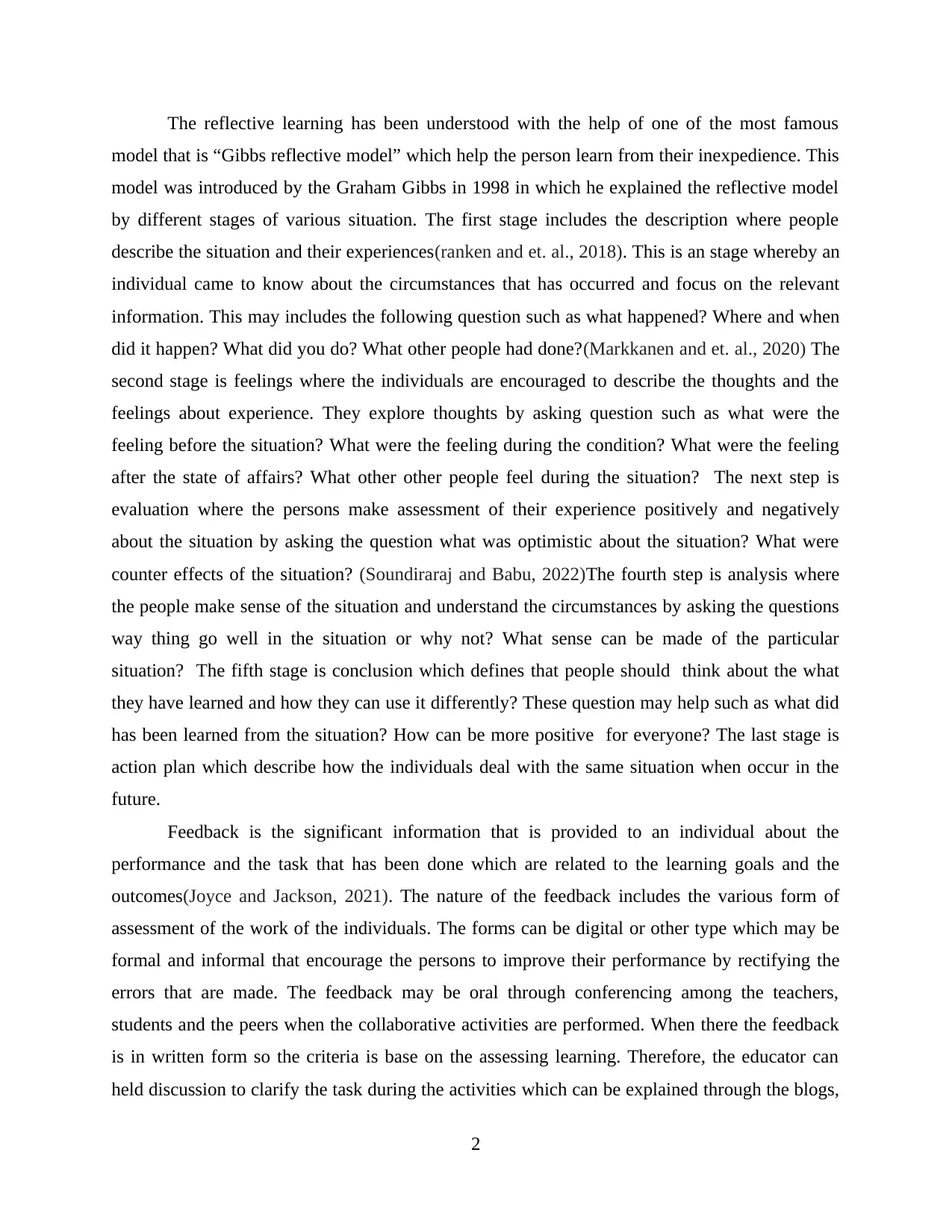
The reflective learning has been understood with the help of one of the most famous
model that is “Gibbs reflective model” which help the person learn from their inexpedience. This
model was introduced by the Graham Gibbs in 1998 in which he explained the reflective model
by different stages of various situation. The first stage includes the description where people
describe the situation and their experiences(ranken and et. al., 2018). This is an stage whereby an
individual came to know about the circumstances that has occurred and focus on the relevant
information. This may includes the following question such as what happened? Where and when
did it happen? What did you do? What other people had done?(Markkanen and et. al., 2020) The
second stage is feelings where the individuals are encouraged to describe the thoughts and the
feelings about experience. They explore thoughts by asking question such as what were the
feeling before the situation? What were the feeling during the condition? What were the feeling
after the state of affairs? What other other people feel during the situation? The next step is
evaluation where the persons make assessment of their experience positively and negatively
about the situation by asking the question what was optimistic about the situation? What were
counter effects of the situation? (Soundiraraj and Babu, 2022)The fourth step is analysis where
the people make sense of the situation and understand the circumstances by asking the questions
way thing go well in the situation or why not? What sense can be made of the particular
situation? The fifth stage is conclusion which defines that people should think about the what
they have learned and how they can use it differently? These question may help such as what did
has been learned from the situation? How can be more positive for everyone? The last stage is
action plan which describe how the individuals deal with the same situation when occur in the
future.
Feedback is the significant information that is provided to an individual about the
performance and the task that has been done which are related to the learning goals and the
outcomes(Joyce and Jackson, 2021). The nature of the feedback includes the various form of
assessment of the work of the individuals. The forms can be digital or other type which may be
formal and informal that encourage the persons to improve their performance by rectifying the
errors that are made. The feedback may be oral through conferencing among the teachers,
students and the peers when the collaborative activities are performed. When there the feedback
is in written form so the criteria is base on the assessing learning. Therefore, the educator can
held discussion to clarify the task during the activities which can be explained through the blogs,
2
model that is “Gibbs reflective model” which help the person learn from their inexpedience. This
model was introduced by the Graham Gibbs in 1998 in which he explained the reflective model
by different stages of various situation. The first stage includes the description where people
describe the situation and their experiences(ranken and et. al., 2018). This is an stage whereby an
individual came to know about the circumstances that has occurred and focus on the relevant
information. This may includes the following question such as what happened? Where and when
did it happen? What did you do? What other people had done?(Markkanen and et. al., 2020) The
second stage is feelings where the individuals are encouraged to describe the thoughts and the
feelings about experience. They explore thoughts by asking question such as what were the
feeling before the situation? What were the feeling during the condition? What were the feeling
after the state of affairs? What other other people feel during the situation? The next step is
evaluation where the persons make assessment of their experience positively and negatively
about the situation by asking the question what was optimistic about the situation? What were
counter effects of the situation? (Soundiraraj and Babu, 2022)The fourth step is analysis where
the people make sense of the situation and understand the circumstances by asking the questions
way thing go well in the situation or why not? What sense can be made of the particular
situation? The fifth stage is conclusion which defines that people should think about the what
they have learned and how they can use it differently? These question may help such as what did
has been learned from the situation? How can be more positive for everyone? The last stage is
action plan which describe how the individuals deal with the same situation when occur in the
future.
Feedback is the significant information that is provided to an individual about the
performance and the task that has been done which are related to the learning goals and the
outcomes(Joyce and Jackson, 2021). The nature of the feedback includes the various form of
assessment of the work of the individuals. The forms can be digital or other type which may be
formal and informal that encourage the persons to improve their performance by rectifying the
errors that are made. The feedback may be oral through conferencing among the teachers,
students and the peers when the collaborative activities are performed. When there the feedback
is in written form so the criteria is base on the assessing learning. Therefore, the educator can
held discussion to clarify the task during the activities which can be explained through the blogs,
2
Paraphrase This Document
Need a fresh take? Get an instant paraphrase of this document with our AI Paraphraser
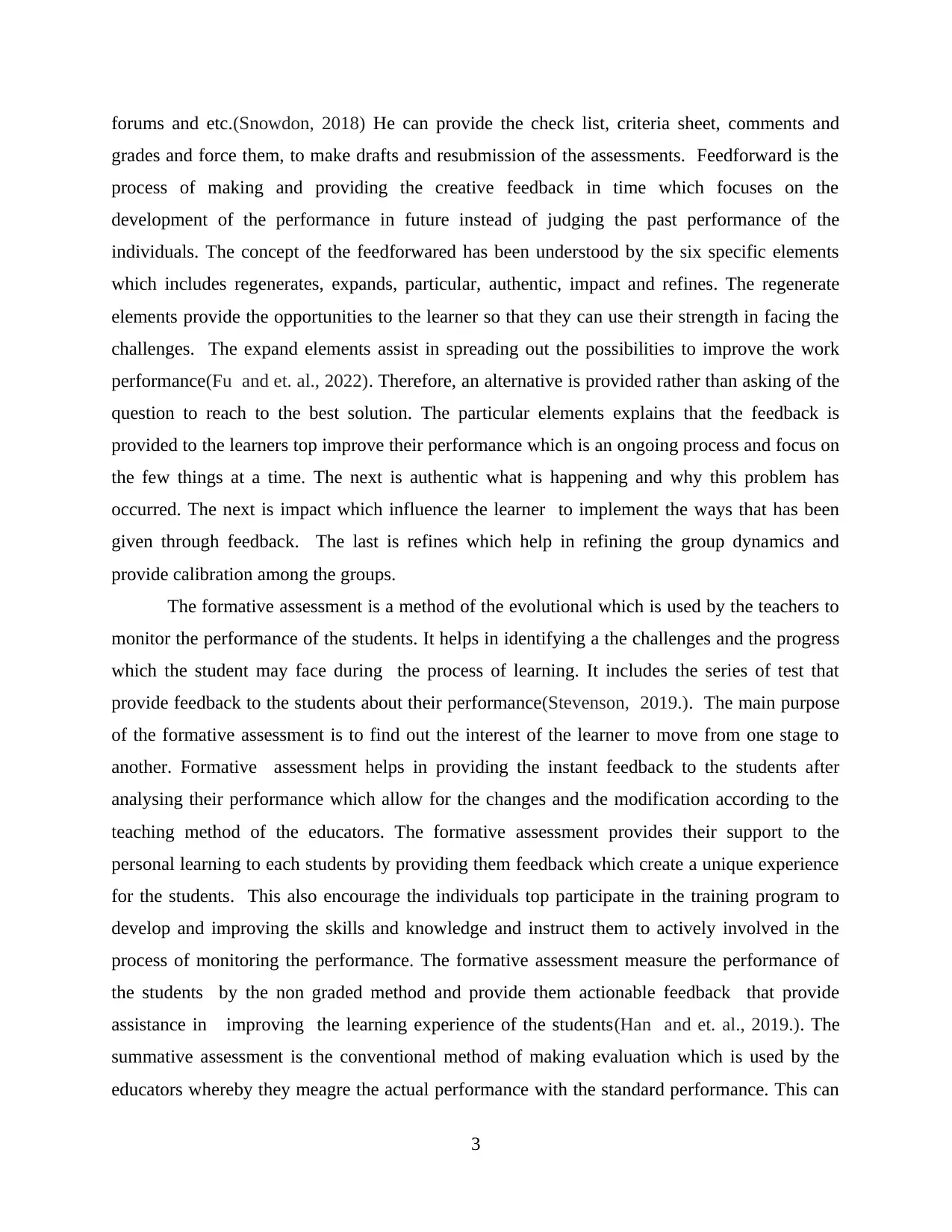
forums and etc.(Snowdon, 2018) He can provide the check list, criteria sheet, comments and
grades and force them, to make drafts and resubmission of the assessments. Feedforward is the
process of making and providing the creative feedback in time which focuses on the
development of the performance in future instead of judging the past performance of the
individuals. The concept of the feedforwared has been understood by the six specific elements
which includes regenerates, expands, particular, authentic, impact and refines. The regenerate
elements provide the opportunities to the learner so that they can use their strength in facing the
challenges. The expand elements assist in spreading out the possibilities to improve the work
performance(Fu and et. al., 2022). Therefore, an alternative is provided rather than asking of the
question to reach to the best solution. The particular elements explains that the feedback is
provided to the learners top improve their performance which is an ongoing process and focus on
the few things at a time. The next is authentic what is happening and why this problem has
occurred. The next is impact which influence the learner to implement the ways that has been
given through feedback. The last is refines which help in refining the group dynamics and
provide calibration among the groups.
The formative assessment is a method of the evolutional which is used by the teachers to
monitor the performance of the students. It helps in identifying a the challenges and the progress
which the student may face during the process of learning. It includes the series of test that
provide feedback to the students about their performance(Stevenson, 2019.). The main purpose
of the formative assessment is to find out the interest of the learner to move from one stage to
another. Formative assessment helps in providing the instant feedback to the students after
analysing their performance which allow for the changes and the modification according to the
teaching method of the educators. The formative assessment provides their support to the
personal learning to each students by providing them feedback which create a unique experience
for the students. This also encourage the individuals top participate in the training program to
develop and improving the skills and knowledge and instruct them to actively involved in the
process of monitoring the performance. The formative assessment measure the performance of
the students by the non graded method and provide them actionable feedback that provide
assistance in improving the learning experience of the students(Han and et. al., 2019.). The
summative assessment is the conventional method of making evaluation which is used by the
educators whereby they meagre the actual performance with the standard performance. This can
3
grades and force them, to make drafts and resubmission of the assessments. Feedforward is the
process of making and providing the creative feedback in time which focuses on the
development of the performance in future instead of judging the past performance of the
individuals. The concept of the feedforwared has been understood by the six specific elements
which includes regenerates, expands, particular, authentic, impact and refines. The regenerate
elements provide the opportunities to the learner so that they can use their strength in facing the
challenges. The expand elements assist in spreading out the possibilities to improve the work
performance(Fu and et. al., 2022). Therefore, an alternative is provided rather than asking of the
question to reach to the best solution. The particular elements explains that the feedback is
provided to the learners top improve their performance which is an ongoing process and focus on
the few things at a time. The next is authentic what is happening and why this problem has
occurred. The next is impact which influence the learner to implement the ways that has been
given through feedback. The last is refines which help in refining the group dynamics and
provide calibration among the groups.
The formative assessment is a method of the evolutional which is used by the teachers to
monitor the performance of the students. It helps in identifying a the challenges and the progress
which the student may face during the process of learning. It includes the series of test that
provide feedback to the students about their performance(Stevenson, 2019.). The main purpose
of the formative assessment is to find out the interest of the learner to move from one stage to
another. Formative assessment helps in providing the instant feedback to the students after
analysing their performance which allow for the changes and the modification according to the
teaching method of the educators. The formative assessment provides their support to the
personal learning to each students by providing them feedback which create a unique experience
for the students. This also encourage the individuals top participate in the training program to
develop and improving the skills and knowledge and instruct them to actively involved in the
process of monitoring the performance. The formative assessment measure the performance of
the students by the non graded method and provide them actionable feedback that provide
assistance in improving the learning experience of the students(Han and et. al., 2019.). The
summative assessment is the conventional method of making evaluation which is used by the
educators whereby they meagre the actual performance with the standard performance. This can
3
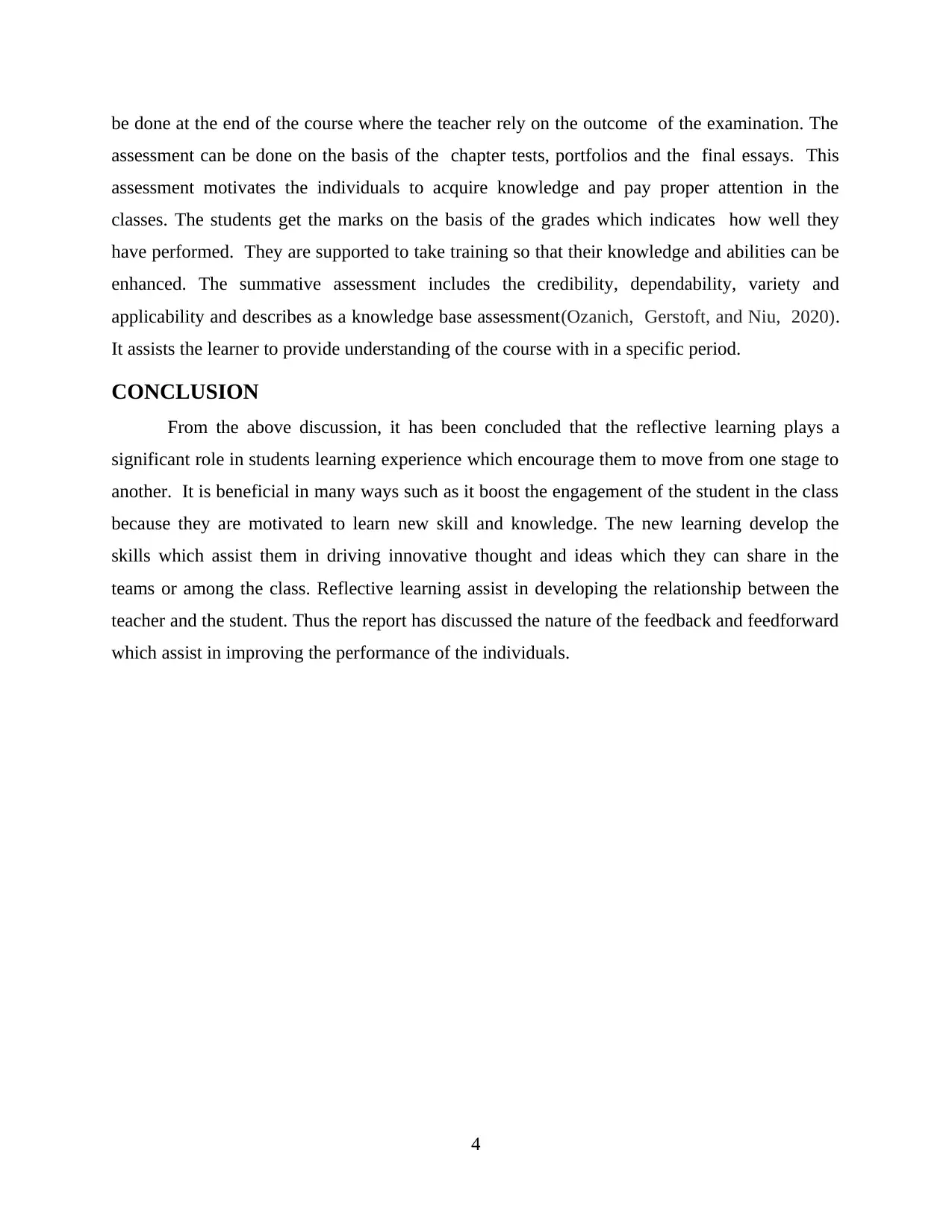
be done at the end of the course where the teacher rely on the outcome of the examination. The
assessment can be done on the basis of the chapter tests, portfolios and the final essays. This
assessment motivates the individuals to acquire knowledge and pay proper attention in the
classes. The students get the marks on the basis of the grades which indicates how well they
have performed. They are supported to take training so that their knowledge and abilities can be
enhanced. The summative assessment includes the credibility, dependability, variety and
applicability and describes as a knowledge base assessment(Ozanich, Gerstoft, and Niu, 2020).
It assists the learner to provide understanding of the course with in a specific period.
CONCLUSION
From the above discussion, it has been concluded that the reflective learning plays a
significant role in students learning experience which encourage them to move from one stage to
another. It is beneficial in many ways such as it boost the engagement of the student in the class
because they are motivated to learn new skill and knowledge. The new learning develop the
skills which assist them in driving innovative thought and ideas which they can share in the
teams or among the class. Reflective learning assist in developing the relationship between the
teacher and the student. Thus the report has discussed the nature of the feedback and feedforward
which assist in improving the performance of the individuals.
4
assessment can be done on the basis of the chapter tests, portfolios and the final essays. This
assessment motivates the individuals to acquire knowledge and pay proper attention in the
classes. The students get the marks on the basis of the grades which indicates how well they
have performed. They are supported to take training so that their knowledge and abilities can be
enhanced. The summative assessment includes the credibility, dependability, variety and
applicability and describes as a knowledge base assessment(Ozanich, Gerstoft, and Niu, 2020).
It assists the learner to provide understanding of the course with in a specific period.
CONCLUSION
From the above discussion, it has been concluded that the reflective learning plays a
significant role in students learning experience which encourage them to move from one stage to
another. It is beneficial in many ways such as it boost the engagement of the student in the class
because they are motivated to learn new skill and knowledge. The new learning develop the
skills which assist them in driving innovative thought and ideas which they can share in the
teams or among the class. Reflective learning assist in developing the relationship between the
teacher and the student. Thus the report has discussed the nature of the feedback and feedforward
which assist in improving the performance of the individuals.
4
⊘ This is a preview!⊘
Do you want full access?
Subscribe today to unlock all pages.

Trusted by 1+ million students worldwide
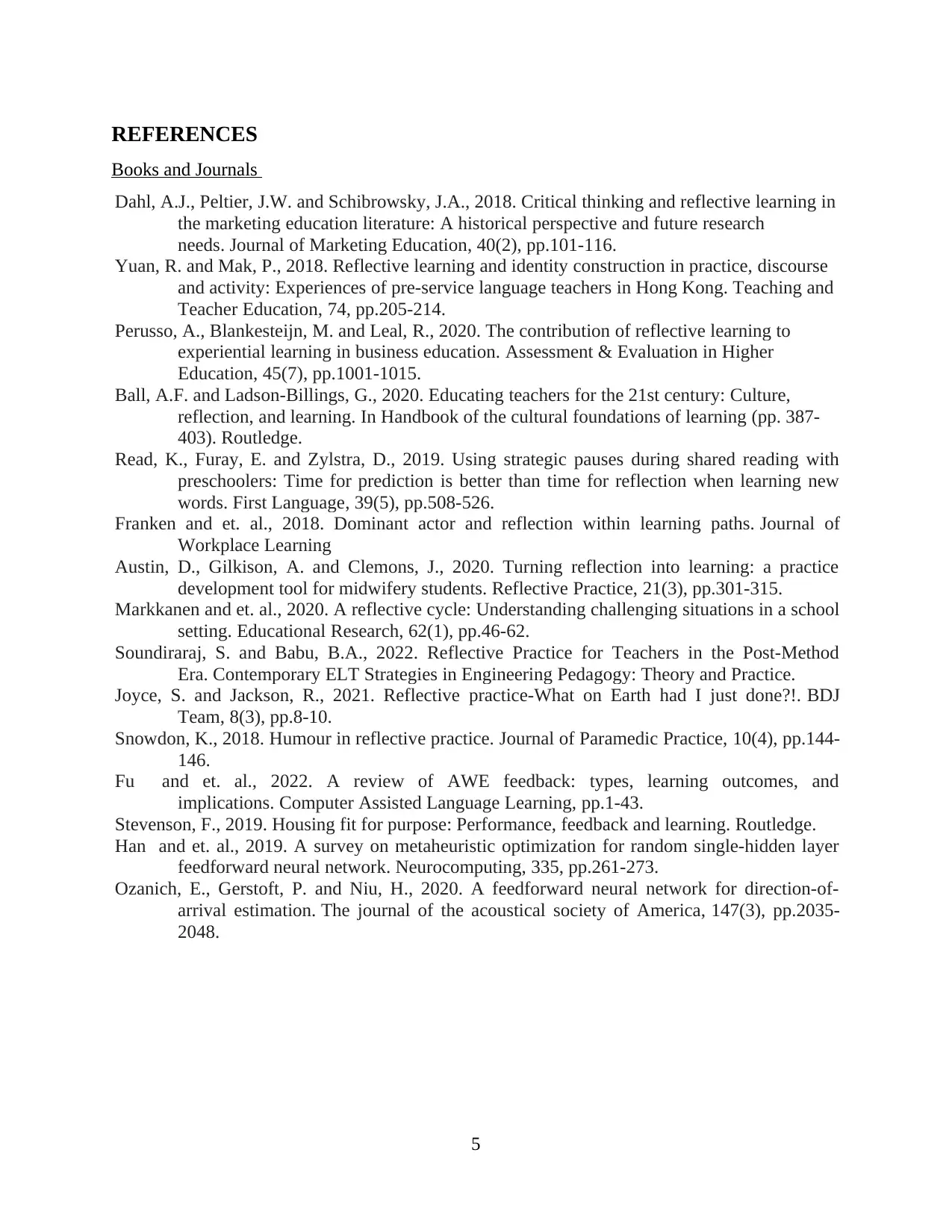
REFERENCES
Books and Journals
Dahl, A.J., Peltier, J.W. and Schibrowsky, J.A., 2018. Critical thinking and reflective learning in
the marketing education literature: A historical perspective and future research
needs. Journal of Marketing Education, 40(2), pp.101-116.
Yuan, R. and Mak, P., 2018. Reflective learning and identity construction in practice, discourse
and activity: Experiences of pre-service language teachers in Hong Kong. Teaching and
Teacher Education, 74, pp.205-214.
Perusso, A., Blankesteijn, M. and Leal, R., 2020. The contribution of reflective learning to
experiential learning in business education. Assessment & Evaluation in Higher
Education, 45(7), pp.1001-1015.
Ball, A.F. and Ladson-Billings, G., 2020. Educating teachers for the 21st century: Culture,
reflection, and learning. In Handbook of the cultural foundations of learning (pp. 387-
403). Routledge.
Read, K., Furay, E. and Zylstra, D., 2019. Using strategic pauses during shared reading with
preschoolers: Time for prediction is better than time for reflection when learning new
words. First Language, 39(5), pp.508-526.
Franken and et. al., 2018. Dominant actor and reflection within learning paths. Journal of
Workplace Learning
Austin, D., Gilkison, A. and Clemons, J., 2020. Turning reflection into learning: a practice
development tool for midwifery students. Reflective Practice, 21(3), pp.301-315.
Markkanen and et. al., 2020. A reflective cycle: Understanding challenging situations in a school
setting. Educational Research, 62(1), pp.46-62.
Soundiraraj, S. and Babu, B.A., 2022. Reflective Practice for Teachers in the Post-Method
Era. Contemporary ELT Strategies in Engineering Pedagogy: Theory and Practice.
Joyce, S. and Jackson, R., 2021. Reflective practice-What on Earth had I just done?!. BDJ
Team, 8(3), pp.8-10.
Snowdon, K., 2018. Humour in reflective practice. Journal of Paramedic Practice, 10(4), pp.144-
146.
Fu and et. al., 2022. A review of AWE feedback: types, learning outcomes, and
implications. Computer Assisted Language Learning, pp.1-43.
Stevenson, F., 2019. Housing fit for purpose: Performance, feedback and learning. Routledge.
Han and et. al., 2019. A survey on metaheuristic optimization for random single-hidden layer
feedforward neural network. Neurocomputing, 335, pp.261-273.
Ozanich, E., Gerstoft, P. and Niu, H., 2020. A feedforward neural network for direction-of-
arrival estimation. The journal of the acoustical society of America, 147(3), pp.2035-
2048.
5
Books and Journals
Dahl, A.J., Peltier, J.W. and Schibrowsky, J.A., 2018. Critical thinking and reflective learning in
the marketing education literature: A historical perspective and future research
needs. Journal of Marketing Education, 40(2), pp.101-116.
Yuan, R. and Mak, P., 2018. Reflective learning and identity construction in practice, discourse
and activity: Experiences of pre-service language teachers in Hong Kong. Teaching and
Teacher Education, 74, pp.205-214.
Perusso, A., Blankesteijn, M. and Leal, R., 2020. The contribution of reflective learning to
experiential learning in business education. Assessment & Evaluation in Higher
Education, 45(7), pp.1001-1015.
Ball, A.F. and Ladson-Billings, G., 2020. Educating teachers for the 21st century: Culture,
reflection, and learning. In Handbook of the cultural foundations of learning (pp. 387-
403). Routledge.
Read, K., Furay, E. and Zylstra, D., 2019. Using strategic pauses during shared reading with
preschoolers: Time for prediction is better than time for reflection when learning new
words. First Language, 39(5), pp.508-526.
Franken and et. al., 2018. Dominant actor and reflection within learning paths. Journal of
Workplace Learning
Austin, D., Gilkison, A. and Clemons, J., 2020. Turning reflection into learning: a practice
development tool for midwifery students. Reflective Practice, 21(3), pp.301-315.
Markkanen and et. al., 2020. A reflective cycle: Understanding challenging situations in a school
setting. Educational Research, 62(1), pp.46-62.
Soundiraraj, S. and Babu, B.A., 2022. Reflective Practice for Teachers in the Post-Method
Era. Contemporary ELT Strategies in Engineering Pedagogy: Theory and Practice.
Joyce, S. and Jackson, R., 2021. Reflective practice-What on Earth had I just done?!. BDJ
Team, 8(3), pp.8-10.
Snowdon, K., 2018. Humour in reflective practice. Journal of Paramedic Practice, 10(4), pp.144-
146.
Fu and et. al., 2022. A review of AWE feedback: types, learning outcomes, and
implications. Computer Assisted Language Learning, pp.1-43.
Stevenson, F., 2019. Housing fit for purpose: Performance, feedback and learning. Routledge.
Han and et. al., 2019. A survey on metaheuristic optimization for random single-hidden layer
feedforward neural network. Neurocomputing, 335, pp.261-273.
Ozanich, E., Gerstoft, P. and Niu, H., 2020. A feedforward neural network for direction-of-
arrival estimation. The journal of the acoustical society of America, 147(3), pp.2035-
2048.
5
Paraphrase This Document
Need a fresh take? Get an instant paraphrase of this document with our AI Paraphraser

6
1 out of 8
Related Documents
Your All-in-One AI-Powered Toolkit for Academic Success.
+13062052269
info@desklib.com
Available 24*7 on WhatsApp / Email
![[object Object]](/_next/static/media/star-bottom.7253800d.svg)
Unlock your academic potential
Copyright © 2020–2025 A2Z Services. All Rights Reserved. Developed and managed by ZUCOL.




